Very High and Very Old
Last time we were in Great Basin NP, it was not possible for us to get up to the Wheeler Peak area. The park has a vehicle length limit (then 22 feet, now 24 feet) for the upper road (which is I believe un-deserved, but a ticket awaits rule-breakers). And we had only Papoose, our small motorcycle, and a snowy, icy road in 40F temperatures. So we didn’t go.
This time was different. It was 80F at camp and 60F at the peak; we had Ralph to drive up in serene comfort; and there was plenty of time to take a hike up into Bristlecone Pine country.
There are few places where this ancient tree grows, and they are uniformly high and remote. The tree is a paradox, in that it prospers only in areas where other trees can barely survive. And prosper it does, not for many score or even hundreds of years, but for thousands of years. Where we were hiking, the older Bristlecone trees were over 3,000 years old. In other parts of the world, the oldest tree has been reliably dated at over 5,000 years of age.
Going to see these trees is not “cheap” in terms of effort. These old gents are not in a drive-by grove. We drove Ralph up near 10,000 feet just to get to the hiking trail. Then we hiked two miles into the back country and 1,200 feet higher to get to the Bristlecone grove. The trail was well-maintained and pretty easy in many spots, wandering past evergreens and lovely streams. Remember, this is the middle of the Nevada desert here – – –
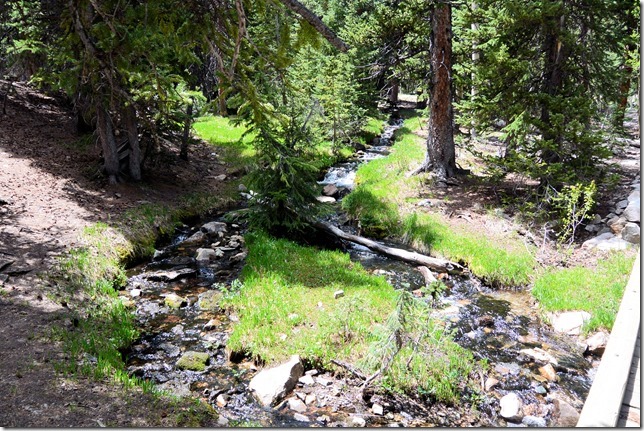
Then the trail climbed, and climbed some more, working up toward the “tree line” where there’s just not enough oxygen for trees to grow any more. Old folks and young folks huff and puff for oxygen too. Actually, both Karin and I were doing pretty well at this altitude (10,500), having spent the last six weeks at 5,000-9,000 feet every day. There were multiple signs at the trail-head warning of altitude sickness, but we felt great and were thoroughly enjoying the hike.
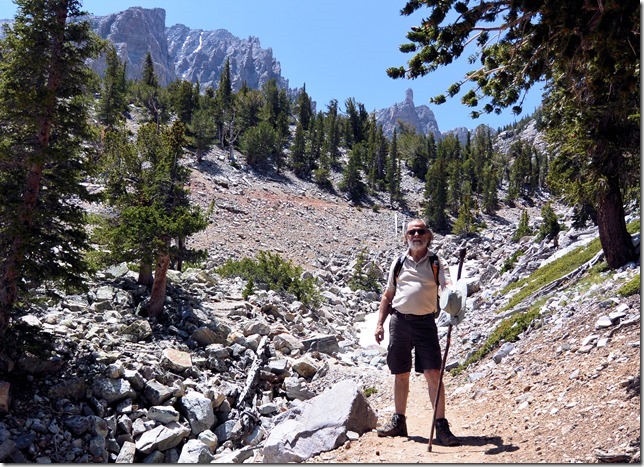
When we reached the grove, the trees were truly beyond impressive. It’s not at all difficult to “feel” the antiquity that surrounds the grove. These trees were already several hundred years old when the First Testament was written, and had passed 1,000 years old when Jesus was born.
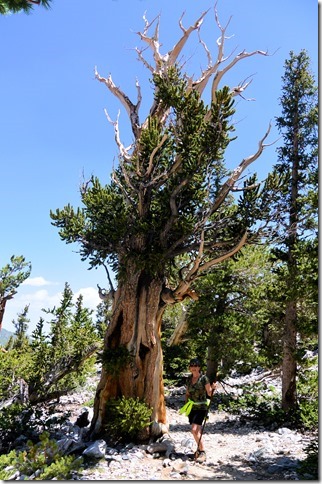 Like all trees, the Bristlecone produces “rings” as it grows, and these are used, along with sophisticated dendrochronology techniques, to accurately date the trees.
Like all trees, the Bristlecone produces “rings” as it grows, and these are used, along with sophisticated dendrochronology techniques, to accurately date the trees.
Since the Bristlecone grows in harsh environs, it grows slowly; the rings are extremely fine and close-spaced. This makes the wood dense, hard, and relatively immune to rot.
Older trees may have 60%, 70%, or even more than 90% of their bulk “dead”, without a cambium layer. But a stripe of cambium will lead to green growth somewhere up in the branches, and the tree is “living”.
The Bristlecone is remarkably efficient – – for example, its needles last up to 40 years before they fall off, 20 times longer than a typical evergreen.
The dense, rot-resistant wood persists long after the tree dies, much longer than other types of wood. A dead Bristlecone can remain standing for more than 1,000 years after its demise. Stripped of its greenery, this old dead tree shows a statuesque elegance, almost as if its spirit were living on within its desiccated skeleton.
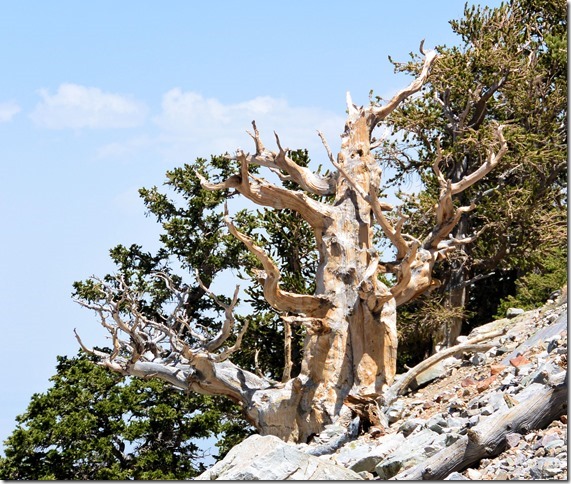
Oddly enough, if a Bristlecone finds a really comfortable spot to grow – – lots of water and nutrients – – it will become “complacent”. Its growth rings will thicken, its wood will decrease in density, and its trunk will often rot out, creating a hollow tree with a shorter life span. We talk about the toughening effect of adversity (“come on, one more pushup!!”), and here is one of the clearest lessons.
We also lucked out on our hike in finding a Ranger who was there to give a “talk”. About 6-8 people gathered ‘round and we heard lots of bits and pieces about Bristlecones’ biology and history. One of the tidbits was the story of how, in 1964, a researcher managed to accidentally cut down the oldest living Bristlecone pine. Too long to tell here, but here is a picture of a slice of that tree, on display in the Visitor Center.
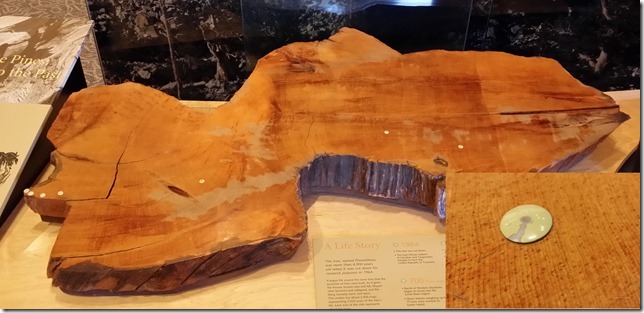
The inset shows a close-up of one area near a thumb-tack marker. You can see that the growth rings are only about 0.020” (a half-mm) thick.
We left the Bristlecone encounter educated, enriched, and content with a day well spent.
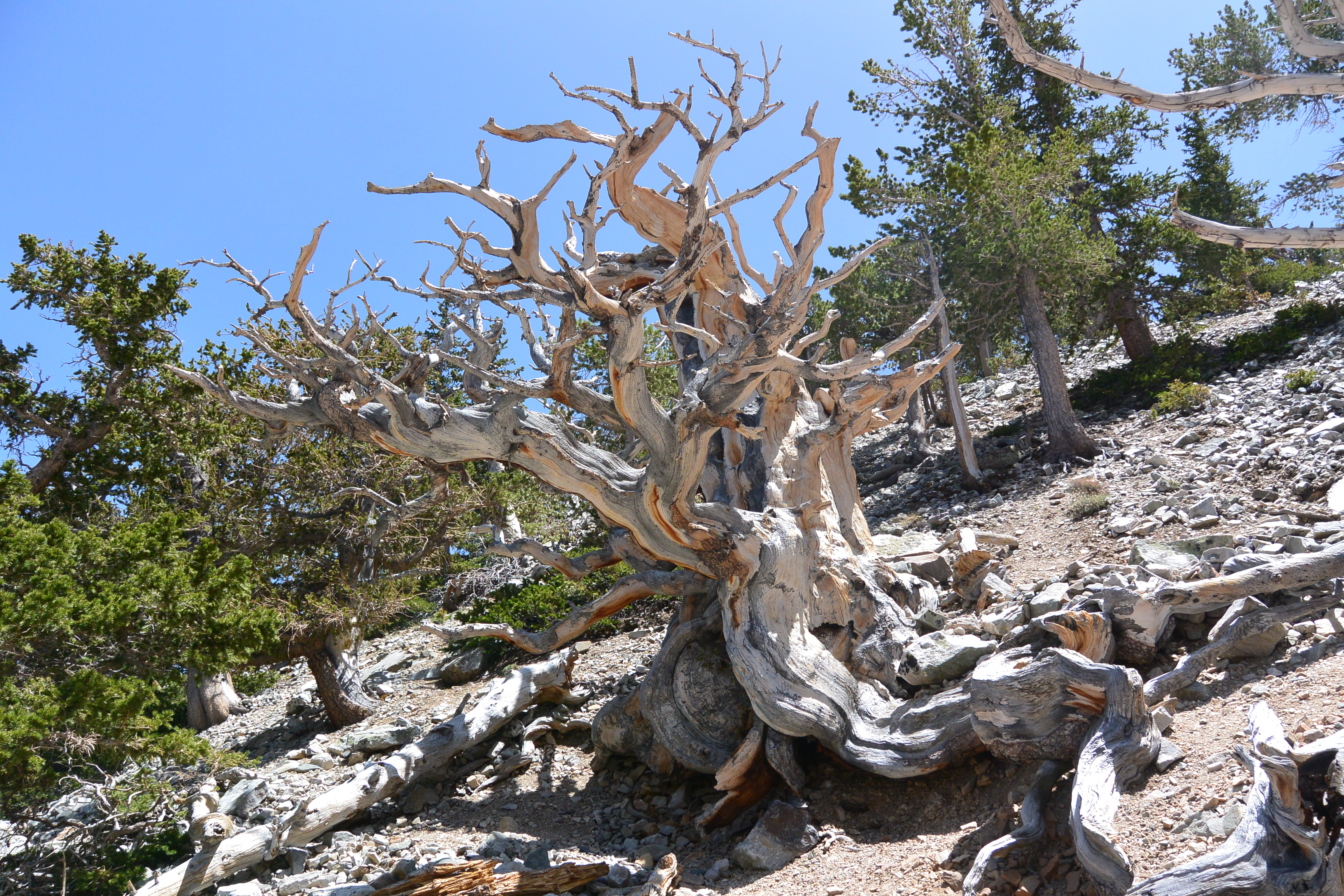
Comments
Very High and Very Old — No Comments
HTML tags allowed in your comment: <a href="" title=""> <abbr title=""> <acronym title=""> <b> <blockquote cite=""> <cite> <code> <del datetime=""> <em> <i> <q cite=""> <s> <strike> <strong>